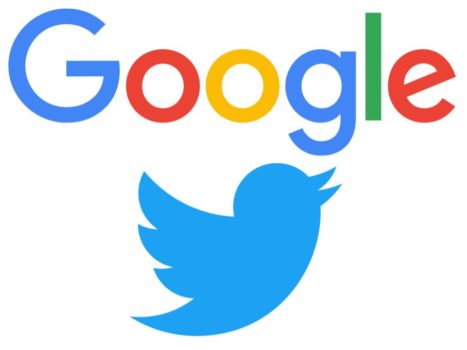Analysis: Google & Twitter Q1 2017 Earnings
by Rebecca Muir on 3rd May 2017 in News

Google are triumphing right now. Despite the YouTube debacle, and resulting advertiser boycott, the company’s stock price reached an all-time peak of USD$937 on 28 April, 2017, after posting favourable Q1 2017 earnings (NASDAQ: GOOGL).
The company saw mobile search and ongoing strength in YouTube driving ad sales higher, while sales on Google Play, hardware, and cloud grew substantially, says chief financial officer, Ruth Porat.
The IAB’s latest digital ad market report shows the tech mammoth seized 49% of the growth of the US digital ad market in 2016. Financial results for the the quarter ended 31 March, 2017 look rosy too: revenue increased by 22%; Advertising revenue rose by 19%; and cost-per-click (CPC) grew by 4%.
The growth in traffic acquisition costs (TAC) roughly match ad revenue growth (18% vs 19%), proving Google’s financial stability and expense management prowess. Furthermore, in total, profit margins rose for the seventh consecutive quarter on both gross revenues (to 26.5%) and against revenue ex-TAC (to 32.6%). Capital expenditures were approximately stable year-on-year, but down as a percentage of revenue at USD$2.5bn (£1.94bn).
Almost half (48%) of Google’s revenue comes from the US; one-third (25%) from EMEA, excluding the UK (8%); 15% from APAC; and revenue from other Americas makes up the remaining 5%.
Over recent years, the LATAM region’s digital advertising economy has gone from strength to strength. Globally, ad spend is set to grow the most this year (6.2%), helped by the 2016 Olympic Games and a general economic recovery, according to a report by MAGNA, IPG Mediabrands' research arm.
Google reports healthy growth across all regions, with other Americas leading the pack at +29%, highlighting the company’s ability to successfully adapt and execute localised strategies.
Following continued concerns over Brexit, and the UK-initiated boycott earlier in the year, growth here is the lowest globally at just +16% (US +25%; EMEA (including the UK) +19%; APAC +26%).
Q1 2017 financial highlights (in millions)
| Three Months Ended March 31, 2016 | Three Months Ended March 31, 2017 | |||
| Revenues | $20,257 | $24,750 | ||
| Increase in revenues year over year | 17% | 22% | ||
| Headcount | 64,115 | 73,992 | ||
Segmented revenues (in millions; unaudited):
| Three Months Ended March 31, 2016 | Three Months Ended March 31, 2017 | ||
| Google advertising revenues | $18,020 | $21,411 | |
| Google other revenues | $2,072 | $3,095 | |
| Other Bets revenues | $165 | $244 |
Traffic acquisition costs (TAC)
| Three Months Ended March 31, 2016 | Three Months Ended March 31, 2017 | |||
| Total TAC | $3,788 | $4,629 | ||
| Total TAC as % of Google advertising revenues | 21 | % | 22 | % |
Paid clicks and cost-per-click information (unaudited):
| Change from Q1 2016 to Q1 2017 (YoY) | Change from Q4 2016 to Q1 2017 (QoQ) | |
| Aggregate paid clicks | 44% | 2% |
| Paid clicks on Google properties | 53% | 1% |
| Paid clicks on Google Network Members' properties | 10% | 6% |
| Aggregate cost-per-click | (19) % | (4) % |
| Cost-per-click on Google properties | (21) % | (3) % |
| Cost-per-click on Google Network Members' properties | (17) % | (9) % |
Twitter
Twitter’s Q1 2017 results were better than expected, with generally positive user trends suggesting that strategies to retain existing users are working. Average monthly active users were 328 million for the quarter, up 6% year-on-year and average daily active usage grew 14% year-on-year, an acceleration from 11% in the fourth quarter, 7% in the third quarter, 5% in the second quarter, and 3% in the first quarter of 2016.
"We're proud to report accelerating growth in daily active usage for the fourth consecutive quarter, up 14% year-on-year”, said Jack Dorsey, CEO, Twitter.
It’s a different story when it comes to ad revenue: results show a decline of 11% globally.
“While we continue to face revenue headwinds, we believe that executing on our plan and growing our audience should result in positive revenue growth over the long term", says Dorsey.
Twitter continues to adopt strategies that align well with up-to-date consumer behaviour trends (original content streaming and self publishing) and compete with rivals Instagram, Snapchat, and Facebook – and it’s paying off. Advertiser feedback about the company’s live and premium video strategies is positive. Twitter is at last able to highlight improved return on investment from audience growth and better pricing.
With 45 million unique viewers of live premium video (compared to 31 million in Q4 2016), more than 800 hours of live premium video streamed during Q1 2017, and rapid growth of the Periscope product (77 million hours of live user generated content produced, up from seven million hours in Q4 2016), Twitter are showing the world they mean business.
A clutch of advertisers have remained loyal to Twitter, despite the issues faced. In their investor letter the company says: “While new deals represent a small portion of total expected revenue, we have signed a number of new advertising agreements with some of our largest advertiser partners.”
If Twitter can maintain ad revenue from these key advertisers, reallocate resources to the highest revenue-generating products, continue to invest in new formats in line with consumer trends, and maintain the financial stability reported in their quarterly investor letter, we may well see Twitter rise again.
EarningsGoogleThe WireTwitter / X








Follow ExchangeWire